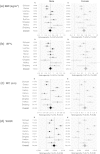Spicy food consumption is associated with adiposity measures among half a million Chinese people: the China Kadoorie Biobank study
- PMID: 25518843
- PMCID: PMC4320519
- DOI: 10.1186/1471-2458-14-1293
Spicy food consumption is associated with adiposity measures among half a million Chinese people: the China Kadoorie Biobank study
Abstract
Background: Few animal experiments and volunteer-based intervention studies have showed a controversial effect of spicy foods on weight management; however, information is scant on the association between spicy food intake and obesity. This study aims to examine the impact of spicy food on quantitative adiposity measures in the Chinese population; a population with a low prevalence of general obesity, but a high prevalence of central obesity.
Methods: A total of 434,556 adults (255,094 females), aged 30-79 years, were included from the China Kadoorie Biobank (CKB) study. Information on spicy food intake was obtained using a questionnaire survey. Body mass index (BMI), percentage body fat (BF%), waist circumference (WC), and WC/height ratio (WHtR) were analyzed as continuous variables.
Results: The prevalence of daily spicy food eating was 30.4% in males and 30.0% in females, with dramatically geographic diversity (ranging from 99.4% in Hunan to 2.7% in Zhejiang). The covariates-adjusted BMI, BF%, WC, and WHtR significantly increased with increasing frequency, strength, and duration of spicy food eating regardless of gender (p < 0.001). Among regular spicy food consumers, strength of spicy food eating showed significant and positive association with all adiposity measures in both genders (except for BF% in males). Compared with non-consumers, daily spicy food eating was significantly associated with an increase of 0.44 and 0.51 of BMI (kg/m2), 0.79 and 1.01 of BF%, 1.4 and 1.0 of WC (cm), and 0.008 and 0.006 of WHtR in males and females, respectively. In stratified analyses of 18 consecutive BMI subgroups, a significantly increasing trend in the effect of daily spicy food eating on WC and WHtR with increasing BMI was noted in males; whereas a decreasing trend was seen in females.
Conclusions: The data indicate that spicy food intake is a risk factor for obesity in Chinese adult population, especially for central obesity in males. Further studies are needed to elucidate the mechanisms underlying this association.
Figures



References
-
- Unschuld PU. “Huang Di Nei Jing Su Wen”: Nature, Knowledge, Imagery in an Ancient Chinese Medical Text: With an Appendix: The Doctrine of the Five Periods and Six Qi in the Huang Di Nei Jing Su Wen. Los Angeles: University of California Press; 2003.
-
- Rozin P. Why We Eat what We Eat, and Why We worry about It. Bull Am Acad Arts Sci. 1997;50:26–48. doi: 10.2307/3824612. - DOI
-
- Derry S, Sven-Rice A, Cole P, Tan T, Moore RA. Topical capsaicin (high concentration) for chronic neuropathic pain in adults. Cochrane Database Syst Rev. 2013;2:CD007393. - PubMed
Pre-publication history
-
- The pre-publication history for this paper can be accessed here: http://www.biomedcentral.com/1471-2458/14/1293/prepub
Publication types
MeSH terms
Grants and funding
LinkOut - more resources
Full Text Sources
Other Literature Sources
Research Materials
Miscellaneous

